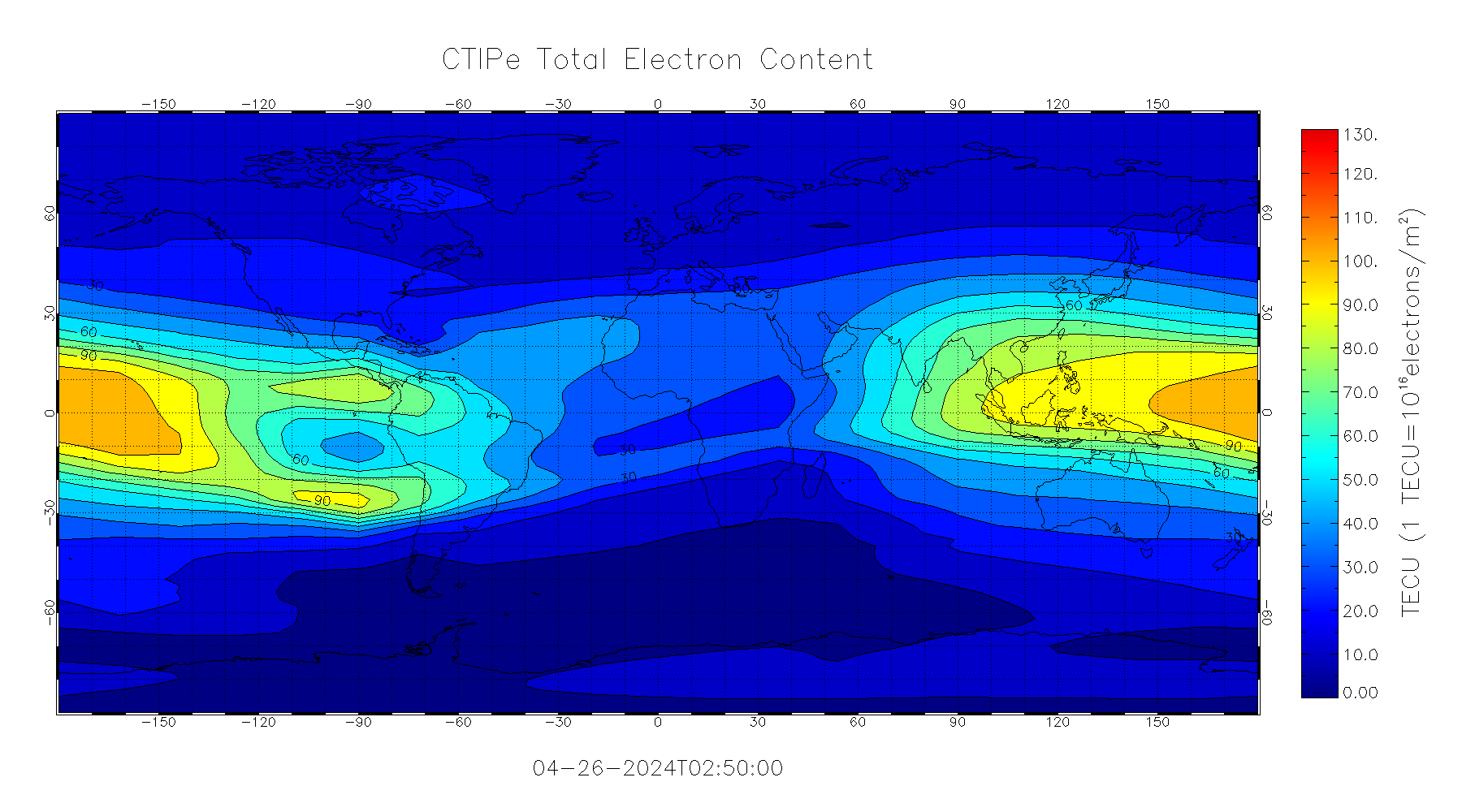
The plot illustrates the height integrated electron density (TECU, 1 TECU = 1.e16 electrons/square meter) also called Vertical Total Electron Content (VTEC), vs latitude (-90 to 90 deg) and longitude (0 - 360 deg) from the Coupled Thermosphere Ionosphere Plasmasphere Electrodynamics Model (CTIPe). CTIPe is a state of the art research tool used at the Space Weather Prediction Center to study thermosphere-ionosphere phenomena in order to develop nowcasting and forecasting algorithms for space weather. The objectives are to understand and quantify the importance of the upper-atmospheric mechanisms that affect human activities and to develop new monitoring and predicting techniques.
Conditions in the ionosphere have a dramatic effect on the accuracy of Global Navigation Satellite Systems (GNSS). Geomagnetic storms can produce large gradients in TEC and the gradients can move making GNSS positioning difficult or impossible at times. The Coupled Thermosphere Ionosphere Plasmasphere Electrodynamics Model (CTIPe) model is a large numerical code that runs about 30 minutes ahead of real-time based on Advanced Composition Explorer (ACE) measurements and has the potential to forecast the state of the thermosphere/ionosphere system, including TEC variability. The model is run and the results are updated every 10 minutes, about 30 minutes ahead of real-time.
The Coupled Thermosphere Ionosphere Plasmasphere Electrodynamics (CTIPe) model is a non-linear, coupled thermosphere-ionosphere-plasmasphere physically based numerical code that includes a self-consistent electrodynamics scheme for the computation of dynamo electric fields. The model consists of four distinct components which run concurrently and are fully coupled. Included are a global thermosphere, a high-latitude ionosphere, a mid and low-latitude ionosphere/plasmasphere and an electrodynamical calculation of the global dynamo electric field. The thermosphere model was originally developed by Fuller-Rowell (Fuller-Rowell and Rees, [1980], Rees et al., [1980]) and is fully described in the PhD thesis of Fuller-Rowell [1981]. The high-latitude ionospheric model was developed by S. Quegan (Quegan, [1982]; Quegan et al., [1982]). The model of Earth’s mid- and low-latitude plasmasphere is based on the Bailey [1983] model. These first three components are described in more detail under the name of coupled thermosphere ionosphere plasmasphere (CTIP) by Millward et al., [1996]. The electrodynamic calculation was developed by Richmond et al., [1992] and was included in the CTIP model by Millward, [2001] resulting in the creation of CTIPe.
The Coupled Thermosphere Ionosphere Plasmasphere Electrodynamics (CTIPe) model runs are performed using real-time ACE measurements from the L1 point to infer the necessary inputs. Because the solar wind takes 30 - 40 minutes to propagate from L1 to the nose of the magnetosphere, the model results are displayed on the web page 20 - 30 minutes ahead of real-time. This is an average time as we do not take into account the current solar wind speed in its calculation. The F10.7 for the previous day averaged with the F10.7 average over the previous 41 days is used to drive the heating, dissociation, and ionization processes. One minute ACE data is used to generate the high-latitude electric potential patterns using the Weimer model and to infer the particle precipitation patterns using correlations between ACE data and the model of auroral precipitation patterns described by Fuller-Rowell and Evans [1987]. The input values (solar wind Btot in the YZ plane, solar wind velocity, IMF angle, solar wind density, and tilt) used for the Weimer model and to infer the particle precipitation pattern are obtained from the SWPC real-time development data base.
The latest model TEC input values are available from: https://services.swpc.noaa.gov/experimental/text/ctipe-tec-input.txt
The latest model TEC output values are available from: https://services.swpc.noaa.gov/experimental/text/ctipe-tec-output.txt
The file ctipe-tec-output.txt contains ascii values of Total Electron Content (TEC) as calculated by the Coupled Thermosphere Ionosphere Plasmasphere Electrodynamics (CTIPe) model.
This file is overwritten every 10 minutes with the latest model results available. Note that the date on the first line in the file may change even if no new inputs were available and no computations were performed since the last update.
The first line is a date in the format: month, day, year, hour, minute. The CTIPe run is generally ahead of real time by 10-20 minutes. This is because it uses ACE data for inputs and it takes the solar wind about 30 minutes from the time of measurement, to affect the ionosphere.
TEC values are listed as follows:
Latitude loop -90 to 90 increasing by 2 degrees each time (geographic coordinates).
(equator is 46)
This results in 91 blocks of 20 values each
Longitude loop 0 to 342 degrees increasing by 18 degrees (geographic coordinates).
This results in 20 TEC values for each latitude starting at the Zero degree Meridian.
Note that all 20 TEC values are the same at each pole.